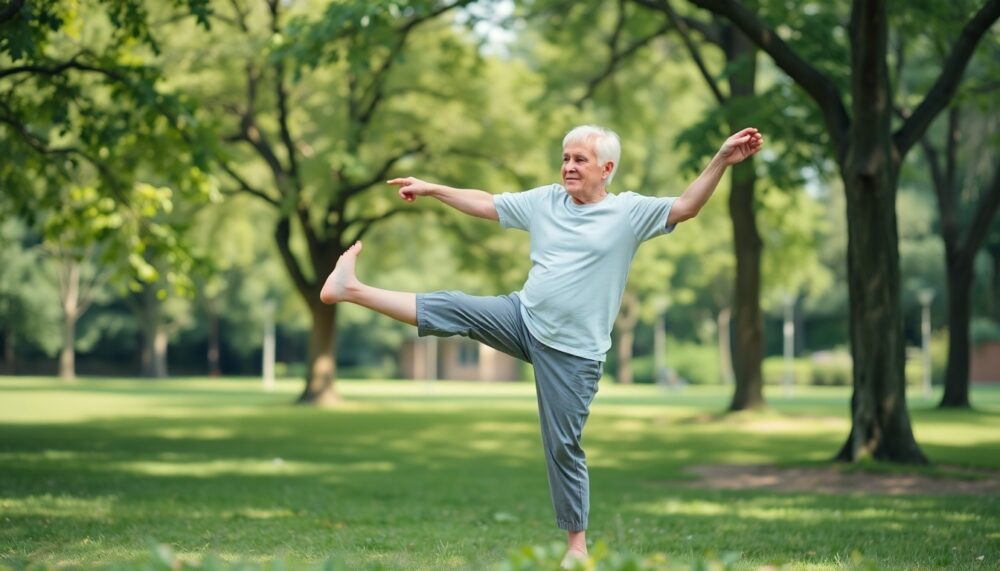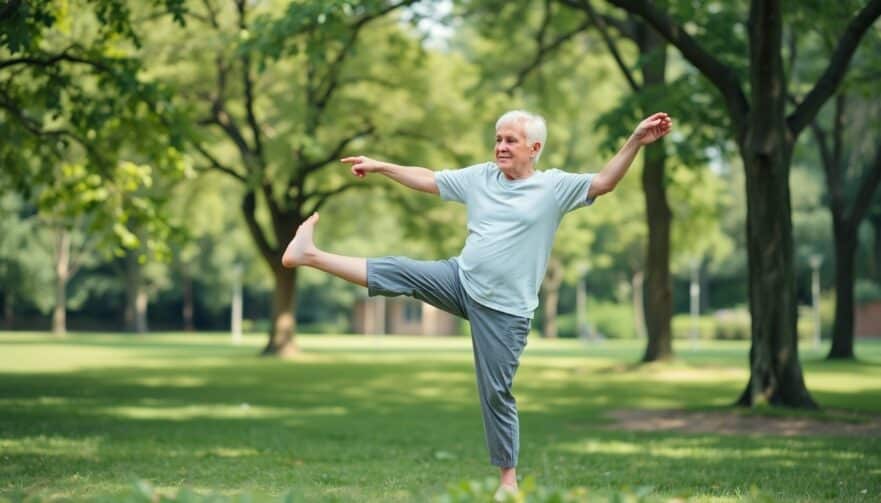
What if I told you that one of the most powerful predictors of how long and how well you’ll live isn’t found in a complex blood test, a stressful treadmill test, or a fancy medical scan? What if it was a simple test you could do right now, in the comfort of your own living room, in less than a minute? It sounds too simple to be true, but a growing body of scientific research is pointing to a fascinating and critical new benchmark for healthy aging: your ability to balance on one leg.
As we get older, we put a lot of focus on diet, exercise, and maintaining muscle mass, and rightly so. But we often overlook a fundamental skill that underpins every single movement we make—our balance. It’s the silent partner in our health, working in the background to keep us upright and safe. New research now shows that the quality of your balance is a surprisingly accurate window into your neurological and musculoskeletal health. In this article, we’re going to dive deep into this groundbreaking science. You’ll learn why this simple test is so important, how to perform it yourself, and most importantly, the exact steps you can take starting today to dramatically improve your stability and invest in a longer, healthier life.
Key Takeaways
- Your ability to stand on one leg is a powerful and scientifically-backed predictor of your overall health, risk of injury, and even your longevity.
- Major studies have revealed a stark connection between poor balance and health outcomes. For example, an inability to balance on one leg for just 10 seconds has been linked to an 84% higher risk of death from any cause in older adults.
- While balance naturally declines with age due to changes in our inner ear, vision, and nerve function, this decline is not inevitable. It is a skill that can be maintained and significantly improved.
- You can reverse this decline with simple, targeted exercises that strengthen key muscles and retrain your brain-body connection. These exercises can be done at home with little to no equipment.
1. Why Balance Is So Much More Than Just Not Falling
When you hear the word “balance,” the first thing that probably comes to mind is avoiding a fall. And while that’s a huge part of it—falls are a leading cause of serious injury and loss of independence in older adults—your sense of balance represents something much deeper. It’s a direct reflection of how well your central nervous system is communicating with your muscular system. This complex process, called proprioception, is like your body’s internal GPS. It involves constant, lightning-fast feedback between sensors in your muscles and joints, your inner ear (the vestibular system), your eyes, and your brain.
When you stand on one leg, you are challenging this entire system in a profound way. Your body has to make thousands of micro-adjustments every second. Your ankle, knee, and hip muscles are constantly firing and relaxing. Your core has to engage to keep your torso stable. Your brain is processing a firehose of information to keep you centered. A strong, stable performance means this entire network is healthy, fast, and efficient. A shaky, short performance, on the other hand, can be an early warning sign that this vital communication network is starting to degrade. This is why it’s a more telling indicator of functional aging than just measuring the raw strength of a single muscle group.
2. The Groundbreaking Research: What Scientists Uncovered
This isn’t just a theory; it’s backed by solid research. A key study from the prestigious Mayo Clinic, published in the journal PLOS One, set out to find the most reliable marker of healthy aging. Researchers took a group of adults aged 50 and older and put them through a series of tests. They measured their walking gait, their grip strength, and the strength of their leg muscles. Then, they tested their balance, ultimately having them stand on one leg for as long as possible.
The results were striking. While muscle strength did decline with age, the most significant and telling difference between the participants was how long they could stand on one leg. The average participant could hold the pose for about 17 seconds, but for those aged 65 and older, that number dropped to just 11 seconds. The researchers concluded that the duration you can stand on one leg is the single most important factor in determining your functional age, more so than grip strength or walking speed. Dr. Kenton Kaufman, the study’s senior author, put it simply: “If you can’t stand on your leg for five seconds, you’re at risk of falls.” Conversely, “If a person can stand on their leg for 30 seconds, they’re doing really well, especially if they’re older.”
3. The 10-Second “Test of Life”: A Stark Warning
If the Mayo Clinic study was the wake-up call, a 2022 study published in the British Journal of Sports Medicine was the fire alarm. This large-scale study followed a group of older adults over several years. The researchers had them perform a simple 10-second, one-legged balance test. What they found was shocking: individuals who were unable to hold the pose for the full 10 seconds had an 84 percent higher risk of death from any cause during the seven-year follow-up period.
Let that sink in. An 84 percent increase. This simple test was more predictive of mortality than many other established risk factors. Now, this isn’t meant to scare you. It’s meant to empower you. This finding highlights that balance isn’t a trivial matter; it’s a vital sign, just like your blood pressure or heart rate. It gives you a simple, free, and immediate tool to assess your risk and, more importantly, a clear signal that it’s time to take action.
4. How to Take the One-Leg Balance Test Yourself
Ready to see where you stand? Here’s how to perform the test safely and accurately at home.
- Find a Safe Space: Stand next to a sturdy chair, countertop, or wall that you can touch for support if you feel unsteady.
- Get into Position: Stand up straight with your feet together and your arms at your sides or crossed over your chest. It’s best to do this barefoot to get the most accurate feedback from the soles of your feet.
- Focus Your Gaze: Pick a spot on the wall in front of you at eye level and keep your gaze fixed on it. This will help you stay stable.
- Begin the Test: Start a timer or watch a clock with a second hand. Lift one foot a few inches off the floor, bending your knee. Don’t let your legs touch.
- Hold the Pose: Stand on your one supporting leg for as long as you can without hopping, wobbling excessively, or having to touch your raised foot to the floor or your hand to your support surface.
- Record Your Time: Stop the timer as soon as you lose your balance. Repeat the test on the other leg. It’s normal for one side to be slightly better than the other.
Interpreting Your Results:
- 30+ Seconds: Excellent! You have fantastic balance and a low risk of falls. Your neuromuscular system is in great shape.
- 10-29 Seconds: Good. This is a solid result, but there is room for improvement. It’s a good time to start incorporating balance exercises to maintain and enhance your stability.
- Under 10 Seconds: This is your call to action. According to the research, this indicates a significantly increased risk of falls and poorer health outcomes. It’s crucial that you begin a balance-training program immediately.
5. Your Action Plan: 4 Simple Exercises to Rebuild Your Balance
The best news is that balance is a highly trainable skill. Your brain and body can form new connections and get stronger at any age. Here are four simple but incredibly effective exercises you can start doing today.
- The Single-Leg Stance: This is the test, but now it’s your training. Aim to hold it for 30 seconds on each leg. If you can’t, start with 10 seconds and build up. Once 30 seconds with your eyes open is easy, try the next progression: close your eyes. You will be amazed at how much harder it is. This forces your body to rely on proprioception and your inner ear, giving them a powerful workout. Start by trying to hold it for just 2-3 seconds with your eyes closed and build from there.
- Heel-to-Toe Walk: Imagine you’re walking on a tightrope. Place the heel of one foot directly in front of the toes of the other foot, so they are touching or almost touching. Take 10-15 slow, deliberate steps forward. Keep your gaze fixed ahead of you. To make it more challenging, try slowly turning your head from side to side as you walk. This disrupts your visual stability and forces your body to work harder.
- Rock the Boat: Stand with your feet hip-width apart. Slowly shift your weight to your right foot, and then lift your left foot out to the side. Hold it there for 15-30 seconds. Then, slowly bring it back to the center and repeat on the other side. This exercise challenges your dynamic balance and strengthens the crucial stabilizing muscles in your hips.
- Chair Squats (with Control): Strong legs, especially your glutes and quads, are essential for balance. Stand in front of a sturdy chair with your feet shoulder-width apart. Slowly lower your hips back and down as if you’re about to sit, keeping your chest up and your core engaged. Go as low as you can with control, either lightly tapping the chair or stopping just before. Then, push through your heels to stand back up. The key is to move slowly and avoid using your hands. This builds strength and control through a full range of motion.
Conclusion
Your ability to balance is not just a party trick; it’s a vital sign that reflects the health of your entire body. The science is clear: the simple one-legged stance test is a powerful tool that gives you honest, immediate feedback on your functional aging. Don’t be discouraged if your time isn’t what you’d hoped. See it as a valuable piece of information and a starting point. Balance is not something you lose forever; it’s a skill you can reclaim. By incorporating these simple exercises into your daily routine, you are not just reducing your risk of a fall. You are actively retraining your brain, strengthening your body, and making a profound investment in a longer, healthier, and more independent future.

